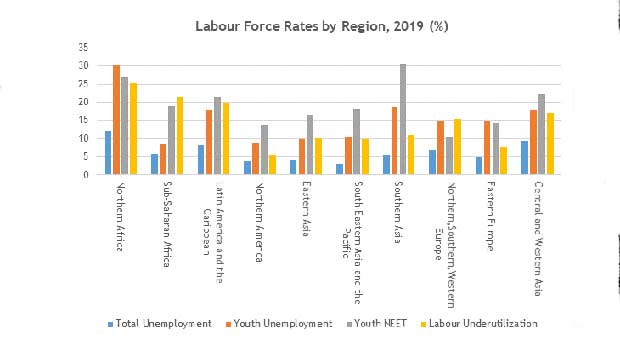Striking at the core of the COVID-19 employment crisis
 19 Mei 2020
19 Mei 2020
By Aurelia Bruce
May 19 2020 (IPS-Partners)
What is happening now
In the early months of 2020, much of the globe was put on pause as governments fought to contain the COVID-19 outbreak. For many, work came to a grinding halt as factories and shops were forced to close their doors, transforming a global health catastrophe into a labour market and economic crisis.
The shock to almost all economic sectors, particularly micro, small and medium-sized enterprises, was instant and severe – essential lockdown measures and restrictions on movement resulted in a surge in insolvencies and lay-offs. Without the financial buffers of investments and savings, many are at risk of:
- • poverty
• poor housing conditions
• malnutrition
• limited access to healthcare
There is particular concern for vulnerable workers such as young people, who are disproportionately affected by poor working conditions, and unstable and informal working arrangements.
What we expect
The Organization for Economic Co-operation and Development (OECD) predicts that some countries could be dealing with the economic fallout of the COVID-19 pandemic for years to come. Preliminary analysis of the economic impact of the outbreak by the International Labour Organisation (ILO), suggests that global unemployment could rise between 5.3 million and 24.7 million.
Although these forecasts are not certain, one might argue they are conservative considering the 22 million jobs that were lost following the 2008 global financial crisis. In the UK, a University of Essex study predicts that the lockdown could cost the country 6.5 million jobs. Restrictions imposed to combat the outbreak are also causing some employers to lower their wages and working hours. In the long-term, this is likely to lead to a rise in underemployment.
During an economic downturn, we would expect an increase of informal self-employment, covering unregulated, unregistered or untaxed activities. However, in the case of this pandemic, incomes from these sources are amongst the hardest-hit.
Globally, workers in this sector are expected to see a 60 per cent decline in earnings, with those in Africa and Latin America losing as much as 81 per cent of their income.
What was happening before
While the forecasts may seem gloomy, the pre-COVID-19 numbers were not exactly encouraging either. For 2019, data from the ILO shows that only 3.3 billion, 57 per cent of the world’s working-age population, were employed. While 2.3 billion people were out of the labour force, another 188 million were unemployed; 165 million were employed but willing and available to work more hours; and 119 million were part of the potential labour force, which includes those who can work but are not seeking employment.
Furthermore, regardless of geographic location, young people in the labour force were facing higher rates of unemployment than adults, as seen in the chart below. Of the 1.3 billion people between ages 15 and 24, one-fifth of them were Not in Education, Employment or Training (NEET), and 75 per cent of them were in informal employment.
Although the potential impact of the pandemic on young people has not been quantified in specific numbers, it is obvious that youth, particularly those in entry-level jobs, non-standard work and those easily replaced by automated processes would be disproportionately affected.
Young workers are also heavily concentrated in sectors most disrupted by restrictions, such as tourism, hospitality and retail. So, the pre-COVID-19 trends tell a story of a tremendously underutilised labour force, particularly amongst our youth who were often left with little to no social protection, paid leave, unemployment benefits or remote working options.

Source: Own creation using ILO data
What needs to happen
In summary, whilst unemployment rates have held relatively steady overall, youth unemployment rates remain twice as high in many regions. Decent work deficits persist and labour underutilisation rates are largely ignored. The socio-economic effects of the pandemic will continue to gravely affect the unemployed globally, with up to an additional 24.7 million people facing job loss.
But along with the challenges, there are opportunities. The current economic recovery plans and COVID-19 response measures offer a chance for countries to address existing and emerging labour market issues.
Across the Commonwealth, there is a strong commitment to working towards a robust and coordinated strategy to tackle underemployment and high youth unemployment, as well as the additional threats posed by the pandemic. That is why the Commonwealth is bringing together governments and experts for a virtual series on the ‘Economics of COVID-19’.
Covid-19 seminar series
Critically, this will provide a space for policymakers to consider forward-thinking and targeted measures to support enterprises and entrepreneurs; and to strike at the core of joblessness, effectively utilising workers’ skills and preparing them for the labour market of the new digital economy
For more information or questions about registration please contact: [email protected]
The author is Assistant Programme Officer Social Policy Division at the Commonwealth Secretariat
The post Striking at the core of the COVID-19 employment crisis appeared first on Inter Press Service.
